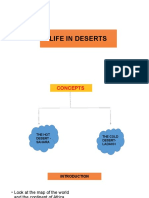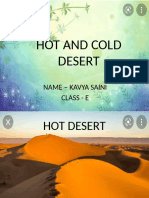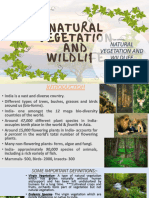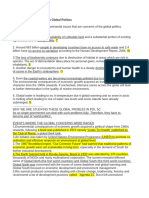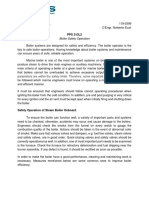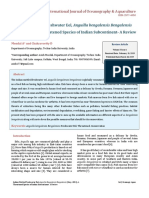0 ratings0% found this document useful (0 votes)
5 viewsLife in Desert
Life in Desert
Uploaded by
piyush sinhaCopyright:
© All Rights Reserved
Available Formats
Download as PPTX, PDF, TXT or read online from Scribd
Life in Desert
Life in Desert
Uploaded by
piyush sinha0 ratings0% found this document useful (0 votes)
5 views12 pagesCopyright
© © All Rights Reserved
Available Formats
PPTX, PDF, TXT or read online from Scribd
Share this document
Did you find this document useful?
Is this content inappropriate?
Copyright:
© All Rights Reserved
Available Formats
Download as PPTX, PDF, TXT or read online from Scribd
Download as pptx, pdf, or txt
0 ratings0% found this document useful (0 votes)
5 views12 pagesLife in Desert
Life in Desert
Uploaded by
piyush sinhaCopyright:
© All Rights Reserved
Available Formats
Download as PPTX, PDF, TXT or read online from Scribd
Download as pptx, pdf, or txt
You are on page 1of 12
Life
Life inin desert
desert
Desert :It is an arid
region characteriesed
by extremely high or
low temperatures and
has scarce vegetation.
By- PIYUSH SINHA
THE HOT DESERT – SAHARA
• The Sahara desert touches eleven
countries. These are Algeria, Chad,
Egypt, Libya, Mali, Mauritania,
Morocco, Niger, Sudan, Tunisia and
Western Saharahese rocky surfaces
• May be more than 2500m high at
some places.
The Sahara Desert • It has an area of around 8.54
millionsq. km
CLIMATE
• The climate of the Sahara desert is scorching hot and
parch dry. It has a short rainy season. The sky is
cloudless and clear. Here, the moisture evaporates
faster than it accumulates. Days are unbelievably hot.
• The temperatures during the day may soar as high as
50°C, heating up the sand and the bare rocks, which in
turn radiates heat making everything around hot.
• The nights may be freezing cold with temperatures
nearing zero degrees
FLORA AND FAUNA
• Vegetation in the Sahara desert
includes cactus, date palms and
acacia.
• In some places there are oasis –
green islands with date palms
surrounding them.
Oasis in the Sahara • Camels, hyenas, jackals, foxes,
Desert scorpions, many varieties of
snakes and lizards are the
prominent animal species living
there.
PEOPLE
• The Sahara desert despite its harsh climate has been inhabited by various
groups of people, who pursue different activities. Among them are the
Bedouins and Tuaregs. These groups are nomadic tribes rearing livestock such
as goats, sheep, camels and horses. These animals provide them with milk,
hides from which they make leather for belts ,clothes and blankets. They wear
heavy robes as protection against dust storms and hot winds.
• The oasis in the Sahara and the Nile Valley in Egypt supports settled
population. Since water is available, the people grow date palms. Crops such
as rice, wheat, barley and beans are also grown. Egyptian cotton, famous
worldwide is grown in Egypt.
• .The cultural landscape of the Sahara is undergoing change. Gleaming glass
cased office buildings tower over mosques and superhighways crisscross the
ancient camel paths. Trucks are replacing camels in the salt trade. Tuaregs are
seen acting as guides to foreign tourists. More and more nomadic herdsmen
are taking to city life finding jobs in oil and gas operations. snakes and lizards
are the prominent animal species
THE COLD DESERT - LADAKH
• Ladakh is a cold desert lying in the Great Himalayas, on the eastern side of
Jammu and Kashmir The Karakoram Range in the north and the Zanskar
mountains in the south enclose it. Several rivers flow through Ladakh, Indus
being the most important among them. The rivers form deep valleys and
gorges . Several glaciers are found in Ladakh, for example the Gangri glacier.
• The altitude in Ladakh varies from about 3000min Kargil to more than 8,000m
in the Karakoram . Due to its high altitude, the climate is extremely coldand
dry. The air at this altitude is so thin that theheat of the sun can be felt
intensely. The day temperatures in summer are just above zero
degreeand the night temperatures well below –30°C. It is freezing cold in the
winters when the temperatures may remain below –40°C for most of the time.
The area experiences freezing winds and burning hot sunlight. You will be surprised to
know that if you sit in thesun with your feet in the shade, you may suffer from both
sunstroke and frost bite at the same time.
FLORA AND FAUNA
• Due to high aridity, the vegetation is sparse. There are
scanty patches of grasses and shrubs for animals to graze.
Groves of willows and poplars are seen in the valleys.
During the summers, fruit trees such as apples, apricots
and walnuts bloom. Several species of birds are sighted in
Ladakh. Robins, redstarts, Tibetan snowcock, raven and
hoopoe are common. Some of these are migratory birds.
The animals of Ladakh are wild goats, wild sheep, yak and
special kinds of dogs. The animals are reared to provide
for the milk, meat and hides. Yak’s milk is used to make
cheese and butter. The hair of the sheep and goat is used
to make woollens
PEOPLE
• In the summer season the people are busy cultivation
barley, potatoes, peas, beans and turnip. The climate in
winter months is so harsh that people keep themselves
engaged in festivities and ceremonies. The women are
very hard working. They work not only in the house and
fields, but also manage small business and shops. Leh, the
capital of Ladakh is well connected both by road and air.
• Life of people is undergoing change due to modernisation.
But the people of Ladakh have over the centuries learned
to live in balance and harmony with nature. Due to scarcity
of resources like water and fuel, they are used with
reverence and care. Nothing is discarded or wasted.
You might also like
- Life in Deserts Chapter 9 Class 7Document16 pagesLife in Deserts Chapter 9 Class 7Gagan HiroliNo ratings yet
- Life in DesertDocument10 pagesLife in DesertSatyabrataNo ratings yet
- CBSE Class 7 Geography Chapter 9 Notes - Life in The Deserts PDFDocument3 pagesCBSE Class 7 Geography Chapter 9 Notes - Life in The Deserts PDFTottle100% (1)
- CBSE Class 7 Geography Notes Chapter 9 Life in The DesertsDocument2 pagesCBSE Class 7 Geography Notes Chapter 9 Life in The Desertszunusa05No ratings yet
- Gess 207Document8 pagesGess 207ZPratt StarkNo ratings yet
- Life in DesertDocument8 pagesLife in DesertaaakhileshNo ratings yet
- 7th Geo Chapter 10Document16 pages7th Geo Chapter 10khanshayan42788No ratings yet
- Social Science Class 7th Chapter Summary.Document8 pagesSocial Science Class 7th Chapter Summary.questgen25No ratings yet
- CH 9 Life in The Deserts 1Document52 pagesCH 9 Life in The Deserts 1Naitik KhuranaNo ratings yet
- Life in The Deserts TableDocument5 pagesLife in The Deserts Tablefaazpro76No ratings yet
- Life in The Desert: Chapter - 9 Social ScienceDocument12 pagesLife in The Desert: Chapter - 9 Social Science4624 DARSHANVNo ratings yet
- Gess 210Document8 pagesGess 210api-309501342No ratings yet
- NCERT Book Class 7 Social Science Our Environment Chapter 9 Life in The DesertDocument10 pagesNCERT Book Class 7 Social Science Our Environment Chapter 9 Life in The DesertsaiNo ratings yet
- Flip ClassDocument8 pagesFlip Classsumanps2020No ratings yet
- NCERT Class 7 Geography Life in The Deserts PDFDocument10 pagesNCERT Class 7 Geography Life in The Deserts PDFfgh ijkNo ratings yet
- Flip Class: Suman Manirtha Nairshtha Harith ManomayDocument9 pagesFlip Class: Suman Manirtha Nairshtha Harith Manomaysumanps2020No ratings yet
- Sahara Desert: by - PurandarDocument10 pagesSahara Desert: by - Purandarpurandar puneetNo ratings yet
- Hot and Cold DesertDocument9 pagesHot and Cold DesertmaheshNo ratings yet
- Chapter 05thehotdesertregion 200822134851Document53 pagesChapter 05thehotdesertregion 200822134851shiralourenco36No ratings yet
- The Cold Desert, LadakhDocument6 pagesThe Cold Desert, Ladakhrupayan majumderNo ratings yet
- Life in DesertDocument4 pagesLife in DesertWindows 7No ratings yet
- Chapter 8 NotesDocument8 pagesChapter 8 Notessargunaquarius7No ratings yet
- STD-7-Geo-L-9 - LIFE IN DESERTSDocument4 pagesSTD-7-Geo-L-9 - LIFE IN DESERTSkoshika.rsjisNo ratings yet
- NOTE BOOK WORK Life in DesertDocument5 pagesNOTE BOOK WORK Life in DesertPrisha RawatNo ratings yet
- Notes Geo CHP 12 Life in The Desert RegionDocument3 pagesNotes Geo CHP 12 Life in The Desert Regionakhaash2809No ratings yet
- T G 851 Ks2 All About The Sahara Desert Fact File Ver 1Document2 pagesT G 851 Ks2 All About The Sahara Desert Fact File Ver 1lekhaNo ratings yet
- Class 7 Geography ch.11: 5. Gompas: Buddhist Monasteries in LadakhDocument3 pagesClass 7 Geography ch.11: 5. Gompas: Buddhist Monasteries in Ladakhmarushika suriNo ratings yet
- Sahara Desert Lesson For Elementary by SlidesgoDocument8 pagesSahara Desert Lesson For Elementary by SlidesgoM MINNAARNo ratings yet
- GeoDocument15 pagesGeoumesh prasad sahuNo ratings yet
- Chapter - 9: Life in The Desert Multiple Choice QuestionsDocument3 pagesChapter - 9: Life in The Desert Multiple Choice QuestionsVibhuti Bhushan Rai100% (1)
- Tundra BiomeDocument17 pagesTundra BiomeFrance KennethNo ratings yet
- MLP-Chap-10-Life in DesertDocument5 pagesMLP-Chap-10-Life in DesertRidhima RaghavNo ratings yet
- Natural Vegetation and Wild LifeDocument76 pagesNatural Vegetation and Wild LifeGagan SinghNo ratings yet
- Major Biomes of The WorldDocument15 pagesMajor Biomes of The Worldraktim.gaziNo ratings yet
- Chapter 5 - Life in The Temperature ZonesDocument32 pagesChapter 5 - Life in The Temperature Zonesvenkat.raghu2012No ratings yet
- B: Desert Climate: Desert, Arabian Desert, Iranian Desert, Thar Desert, Kalahari and Namib DesertsDocument8 pagesB: Desert Climate: Desert, Arabian Desert, Iranian Desert, Thar Desert, Kalahari and Namib DesertsVikram DasNo ratings yet
- Deserts of IndiaDocument10 pagesDeserts of IndiaHpNo ratings yet
- Sahara Desert - Science PioloDocument6 pagesSahara Desert - Science PioloEsperanza M. GarciaNo ratings yet
- Desert EcosystemDocument52 pagesDesert Ecosystemsanakhan05866No ratings yet
- Life in desert-WPS OfficeDocument12 pagesLife in desert-WPS OfficeshivambhatiaNo ratings yet
- Sahara DesertDocument11 pagesSahara DesertsolanitaNo ratings yet
- Flora: Leh Ladakh Jammu and Kashmir IndiaDocument39 pagesFlora: Leh Ladakh Jammu and Kashmir IndiamahadevanNo ratings yet
- Dessert RegionDocument4 pagesDessert RegionsaraNo ratings yet
- SaharaDocument2 pagesSaharaNguyễn Hải ĐăngNo ratings yet
- The Geography of The Sahara Desert - An In-Depth AnalysisDocument4 pagesThe Geography of The Sahara Desert - An In-Depth Analysisnafishasnain0No ratings yet
- Script WDocument3 pagesScript WegageNo ratings yet
- Natural Vegetation and Wildlife Resources-CompressedDocument34 pagesNatural Vegetation and Wildlife Resources-Compressedcome2sandhyaNo ratings yet
- Natural vegetation and wildlife - PPTDocument86 pagesNatural vegetation and wildlife - PPTsomethingssmthngNo ratings yet
- The Ecosystem of Ahaggar MountainsDocument11 pagesThe Ecosystem of Ahaggar Mountainsasmamazouz090No ratings yet
- Life in Deserts Note BookDocument2 pagesLife in Deserts Note BookruthukrishnaarunNo ratings yet
- Desert Ecosystems: Case Study by Kim KerrDocument13 pagesDesert Ecosystems: Case Study by Kim KerrMohamad El MawlaNo ratings yet
- Hot Regions LandscapesDocument19 pagesHot Regions LandscapesValery GvNo ratings yet
- Life On EarthDocument18 pagesLife On EarthJamie MarizNo ratings yet
- Lets Us Explore AfricaDocument59 pagesLets Us Explore AfricaRonald CaderaoNo ratings yet
- Vii - Rev PPT 6 Map & Life in DesertDocument32 pagesVii - Rev PPT 6 Map & Life in Desertmm22b002No ratings yet
- Research On Thar Desert - EditedDocument1 pageResearch On Thar Desert - EditedAdeeba Raheel QureshiNo ratings yet
- Physical Geography of AfricaDocument23 pagesPhysical Geography of AfricaFalilou100% (1)
- BCSSL Lec15 Butterfly Distribution & Population Variation in Sri LankaDocument60 pagesBCSSL Lec15 Butterfly Distribution & Population Variation in Sri LankaMadushanNo ratings yet
- Most Dangerous Deserts In The World | Deserts Of The World for Kids | Children's Explore the World BooksFrom EverandMost Dangerous Deserts In The World | Deserts Of The World for Kids | Children's Explore the World BooksNo ratings yet
- Ecosystem Facts That You Should Know - The Savanna and Tundra Edition - Nature Picture Books | Children's Nature BooksFrom EverandEcosystem Facts That You Should Know - The Savanna and Tundra Edition - Nature Picture Books | Children's Nature BooksNo ratings yet
- May 2020 MockDrill Test 3 PDFDocument30 pagesMay 2020 MockDrill Test 3 PDFpiyush sinhaNo ratings yet
- May_2020_MockDrill_Test_1_PDFDocument33 pagesMay_2020_MockDrill_Test_1_PDFpiyush sinhaNo ratings yet
- Syllabus 2024-25 Cl ViiiDocument23 pagesSyllabus 2024-25 Cl Viiipiyush sinhaNo ratings yet
- Russian Revolution Short SkitDocument2 pagesRussian Revolution Short Skitpiyush sinhaNo ratings yet
- Untitled DocumentDocument3 pagesUntitled Documentpiyush sinhaNo ratings yet
- 12e. Particular Specs (Plumbing)Document42 pages12e. Particular Specs (Plumbing)VISHAL SINGHNo ratings yet
- Ws PROJECTDocument129 pagesWs PROJECTTemesgen Yohannes100% (1)
- Ramsar ConventionDocument36 pagesRamsar ConventionBevs Dela CruzNo ratings yet
- Waste Wate 19Document3 pagesWaste Wate 19anonymousNo ratings yet
- The Drinking Water Treatment ProcessDocument17 pagesThe Drinking Water Treatment ProcessMarvin SironNo ratings yet
- GOG Hydrology Report - AnjunemDocument61 pagesGOG Hydrology Report - AnjunemNeil AgshikarNo ratings yet
- Open DrainDocument6 pagesOpen DrainMohammad MohseniNo ratings yet
- 04 Manifold HydraulicsDocument29 pages04 Manifold HydraulicsVeena NageshNo ratings yet
- PTEC BrochuresDocument15 pagesPTEC BrochuresMagin Idelfonso TorreblancaNo ratings yet
- Gop-Uty-09 (CT 1)Document39 pagesGop-Uty-09 (CT 1)Warda YousafNo ratings yet
- Mccabe H2o Plus Water Level Indicator Paste Msds 1Document5 pagesMccabe H2o Plus Water Level Indicator Paste Msds 1api-525617690No ratings yet
- The Tropical Rainforest NotesDocument8 pagesThe Tropical Rainforest NotesEdwardNo ratings yet
- NAACP MemoDocument2 pagesNAACP Memoaswarren77No ratings yet
- The Occurrence of Cyanobacteria Blooms in Freshwater Ecosystems and Their Link With Hydro-Meteorological and Environmental Variations in TanzaniaDocument23 pagesThe Occurrence of Cyanobacteria Blooms in Freshwater Ecosystems and Their Link With Hydro-Meteorological and Environmental Variations in Tanzaniaall green associatesNo ratings yet
- New Microsoft Word DocumentDocument13 pagesNew Microsoft Word DocumentNandaNo ratings yet
- Wetlands Powerpoint ppx5Document7 pagesWetlands Powerpoint ppx5api-531513728No ratings yet
- Poster Template PARTIAL REPLACEMETN OF CEMENT BY SLUDGE ASH PDFDocument1 pagePoster Template PARTIAL REPLACEMETN OF CEMENT BY SLUDGE ASH PDFAshish Goklani100% (1)
- Class 3 ScienceDocument1 pageClass 3 ScienceSujap BasnetNo ratings yet
- Research EssayDocument8 pagesResearch EssayDezerie Mae SolascoNo ratings yet
- Environmental Concerns in Global Politics - WorldDocument5 pagesEnvironmental Concerns in Global Politics - WorldaddhyangoswamiNo ratings yet
- Dams - C5 - Foundation and Abutment PreparationDocument4 pagesDams - C5 - Foundation and Abutment PreparationJohan Vd Merwe Snr100% (1)
- Mass Balance For Separation Process by Using ExcellDocument3 pagesMass Balance For Separation Process by Using ExcellchemicallordNo ratings yet
- Transport Trapping Woody Debris River Meander ELJS JABMDocument11 pagesTransport Trapping Woody Debris River Meander ELJS JABMJhon Alex Bautista MejiaNo ratings yet
- How To Destroy A BoilerDocument22 pagesHow To Destroy A BoilerJoffre BourgeoisNo ratings yet
- AnupriyaDocument68 pagesAnupriyaLahunWanniang100% (2)
- PPS Boiler Safe OperationDocument9 pagesPPS Boiler Safe OperationAraNo ratings yet
- Axeon 7 JT-series LinkedDocument2 pagesAxeon 7 JT-series LinkedJoannaNo ratings yet
- IJOAC16000162 Indian Mottled EelDocument5 pagesIJOAC16000162 Indian Mottled EelNirvanajunctureNo ratings yet
- Smart City SolutionsDocument10 pagesSmart City SolutionsRAJ VIGNESHNo ratings yet
- Reconstruction of The Actor Collaboration Model in The Development of Marine Tourism Destinations in The New Normal Local EconomyDocument16 pagesReconstruction of The Actor Collaboration Model in The Development of Marine Tourism Destinations in The New Normal Local EconomyYaya HizmiNo ratings yet
